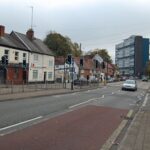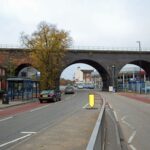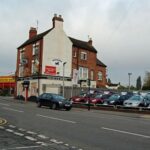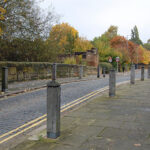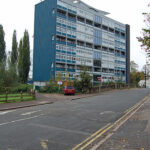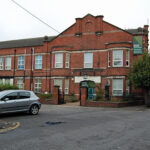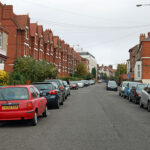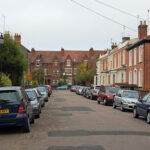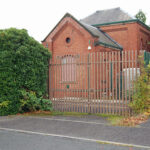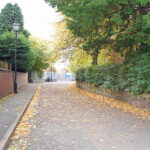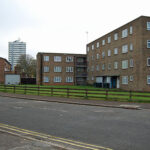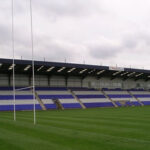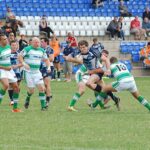Spon End
Homepage » Spon End
Spon End
By 1410, Spon End stretched from St John’s Church to the junction of what is
now Allesley Old Road and Hearsall Lane, the site of the leper hospital in Chapelfields, which survived until about 1800. One of the distinctive landmarks of Spon End is the Coventry – Nuneaton railway that runs through Spon End
over a quarter-mile-long arched railway viaduct which was built in 1848. However disaster struck in 1857, when 23 of the 28 sandstone arches collapsed overnight. Fortunately no one was injured because the collapsed was in the
early hours of the morning and no people were in the street and no train travelling over the bridge. The line was not reopened until 1860 when the replacement arches were constructed of blue brick. The rest of the viaduct is
still the original Warwickshire sandstone.
Records going back to the 14th and 15th centuries reflect the trades that took advantage of the River Sherbourne in Spon End – dyers, tanners,
whittawers and carriers. Several weavers’ topshops survive in old Spon End Broomfield Place. In Upper Spon Street there is a weavers cottage that has been fully restored and this heritage building is open to the public from time
to time.
By the 19th century the watch making trade was the main source of work. The 1851 census shows the area was given over almost entirely to watch making and associated trades. Until the development of Chapelfields, Spon End
was the centre of the Coventry watch making industry.
During the 18th and 19th centuries the land to the north and south of Spon
Street was rapidly developed to house a rapidly expanding population. Spon End was the only area outside the city wall where development had been permitted in the 18th and early 19th Centuries. The area to the south of Spon
Street became a working class area of terraced streets, back to back housing and courts with small dwellings. To the north of Spon Street was an area of houses developed for the professional classes. Development continued along
Holyhead Road and Coundon Road.
An increasing population and an expansion of industry needed a good water supply as well as housing. In 1844 by the Coventry Water Act was passed, which authorised the construction of a waterworks and the sinking of a deep
artesian well in Doe Bank Lane. The works was completed in 1847 at a cost of £29,000 and later expanded to two large pumping houses with tall chimneys visible from all over the area. The works closed in the 1970’s and the
chimneys have gone but the well is still there and is still supplying water. The well house can be seen in Cumbria Close. The original waterworks manager’s house is still at the end of Doe Bank Lane with the original sandstone
wall. The house is now privately owned.
Many famous industrial names are associated with Spon End. Among them
were Renold Chain and Rotherham’s. J. K. Starley, inventor of the modern
safety cycle and founder of Rover, lived in Gloucester Street. The Rudge-
Whitworth works (now the site of the SkyDome complex) employed 1,800
people and in its time was the largest cycle works in the world (later taken
over by GEC and demolished in 1992). As well as the cycle, Coventry is the birthplace of the British production motor car. Alvis cars were first
produced at their works behind Northumberland Road, which took a direct hit
by a bomb in 1941 and never reopened on this site. There is also evidence of motor
manufacturing in Barras Lane and Spon Street.
On the whole, the area escaped major destruction during World War II, particularly the heavy bombing raids of 1940 and 1941. There was some
bomb damage to the Alvis works, Spon Street School, St Osburg’s Church(the oldest Roman Catholic church in Coventry) and private houses, but not on the scale seen in other parts of Coventry.
Ironically, after the war in the 1950s and ’60s the area saw extensive
demolition and redevelopment. Virtually all of the medieval and Victorian
buildings to the south of Upper Spon Street/Spon End, and some to the north,
were demolished and replaced by concrete social housing . A small portion of Spon Street within the ring road was preserved and restored. The larger part of Spon
Street/End outside the ring road was left cut off from the city centre by the ring road.
Because of its history the historic buildings that have survived are worth protecting.
Spon Enders are very proud of the area and it is interesting that although some of the buildings from the 60’s, 70’s and later have been victims of some minor vandalism, the older heritage buildings are not vandalised even
though they are unprotected.
Spon End is home to the Butts Park Arena where Coventry RFC play rugby union and Coventry Bears play rugby league.
Spon End is one of the oldest areas in Coventry. In the 12th century it was known as ‘Sponn’ or ‘Spanne’, a wooded approach to the west of the city. It was an independent community, with its own common, fields, wood, mill and
waste. Spon End was outside of the City Wall. It was the main approach to the city from Shrewsbury and Chester – important centres at that time. People entered the city through Spon Gate which was next to St John the Baptist
Church, which is still standing and is a much loved and used Parish Church. The Spon Gate stood from circa 1391 to 1771. This was approached by a causeway (now Spon Street) which led to a packhorse bridge, in existence in the
late 13th century.
There was a ford for wheeled vehicles, but travellers often had to wait for hours until the River Sherbourne had subsided. The river was much more substantial in those days and flooded on a regular basis. The present Spon Bridge
was constructed in 1771 following a disastrous flood. The area remained prone to flooding until a major flood relief scheme was completed in 1972.
By 1410, Spon End stretched from St John’s Church to the junction of what isnow Allesley Old Road and Hearsall Lane, the site of the leper hospital in Chapelfields, which survived until about 1800. One of the distinctive
landmarks of Spon End is the Coventry – Nuneaton railway that runs through Spon End over a quarter-mile-long arched railway viaduct which was built in 1848. However disaster struck in 1857, when 23 of the 28 sandstone arches
collapsed overnight. Fortunately no one was injured because the collapsed was in the early hours of the morning and no people were in the street and no train travelling over the bridge. The line was not reopened until 1860
when the replacement arches were constructed of blue brick. The rest of the viaduct is still the original Warwickshire sandstone.
Records going back to the 14th and 15th centuries reflect the trades that took advantage of the River Sherbourne in Spon End – dyers, tanners,whittawers and carriers. Several weavers’ topshops survive in old Spon End Broomfield
Place. In Upper Spon Street there is a weavers cottage that has been fully restored and this heritage building is open to the public from time to time.
By the 19th century the watch making trade was the main source of work. The 1851 census shows the area was given over almost entirely to watch making and associated trades. Until the development of Chapelfields, Spon
End was the centre of the Coventry watch making industry.
During the 18th and 19th centuries the land to the north and south of SponStreet was rapidly developed to house a rapidly expanding population. Spon End was the only area outside the city wall where development had been
permitted in the 18th and early 19th Centuries. The area to the south of Spon Street became a working class area of terraced streets, back to back housing and courts with small dwellings. To the north of Spon Street was an
area of houses developed for the professional classes. Development continued along Holyhead Road and Coundon Road.
An increasing population and an expansion of industry needed a good water supply as well as housing. In 1844 by the Coventry Water Act was passed, which authorised the construction of a waterworks and the sinking of a deep
artesian well in Doe Bank Lane. The works was completed in 1847 at a cost of £29,000 and later expanded to two large pumping houses with tall chimneys visible from all over the area. The works closed in the 1970’s and the
chimneys have gone but the well is still there and is still supplying water. The well house can be seen in Cumbria Close. The original waterworks manager’s house is still at the end of Doe Bank Lane with the original
sandstone wall. The house is now privately owned.
Many famous industrial names are associated with Spon End. Among themwere Renold Chain and Rotherham’s. J. K. Starley, inventor of the modernsafety cycle and founder of Rover, lived in Gloucester Street. The Rudge-Whitworth
works (now the site of the SkyDome complex) employed 1,800people and in its time was the largest cycle works in the world (later takenover by GEC and demolished in 1992). As well as the cycle, Coventry is the birthplace of
the British production motor car. Alvis cars were firstproduced at their works behind Northumberland Road, which took a direct hitby a bomb in 1941 and never reopened on this site. There is also evidence of
motormanufacturing in Barras Lane and Spon Street.
On the whole, the area escaped major destruction during World War II, particularly the heavy bombing raids of 1940 and 1941. There was somebomb damage to the Alvis works, Spon Street School, St Osburg’s Church(the oldest
Roman Catholic church in Coventry) and private houses, but not on the scale seen in other parts of Coventry.
Ironically, after the war in the 1950s and ’60s the area saw extensive demolition and redevelopment. Virtually all of the medieval and Victorianbuildings to the south of Upper Spon Street/Spon End, and some to the north,were
demolished and replaced by concrete social housing . A small portion of Spon Street within the ring road was preserved and restored. The larger part of SponStreet/End outside the ring road was left cut off from the city
centre by the ring road.Because of its history the historic buildings that have survived are worth protecting.
Spon Enders are very proud of the area and it is interesting that although some of the buildings from the 60’s, 70’s and later have been victims of some minor vandalism, the older heritage buildings are not vandalised even
though they are unprotected.
Spon End is home to the Butts Park Arena where Coventry RFC play rugby union and Coventry Bears play rugby league.
Just click on the thumb nail images to see a slide show of Spon End.


